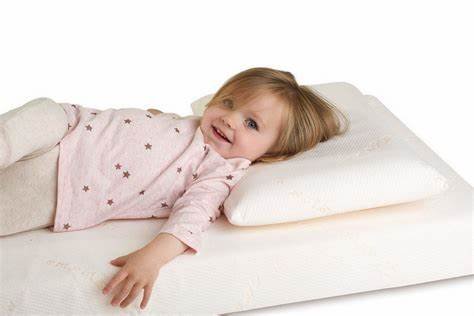Choosing the right pillow for your toddler can feel overwhelming. With so many options available, it’s easy to get lost in a sea of fluff and confusion. This guide will help you navigate the world of toddler pillows, providing you with the information you need to make an informed decision for your little one’s comfort and safety.
Why Do Toddlers Need Special Pillows?
Developing Spine: Toddlers are still growing and developing.1 Their spines are not fully formed, and using an adult pillow can be detrimental.2 Adult pillows are often too thick and can misalign a child’s neck, potentially leading to discomfort, poor sleep quality, and even long-term spinal issues.3
Safety: Adult pillows pose a suffocation risk for infants and toddlers.4 Young children can easily bury their faces in the soft material, obstructing their airways.5
Comfort and Support: Toddler pillows are specifically designed to provide the right amount of support for their developing bodies.6 They are typically thinner and flatter than adult pillows, allowing for proper head and neck alignment.7
Key Features of a Good Toddler Pillow
Size and Shape: Toddler pillows are smaller than adult pillows, usually measuring around 12-14 inches. They come in various shapes, including rectangular, square, and contoured designs.
Material: Look for pillows made from breathable and hypoallergenic materials such as cotton, bamboo, or organic materials.8 Avoid pillows filled with feathers or down, as these can be a choking hazard.
Firmness: The ideal firmness depends on your child’s preferences and needs. Some toddlers may prefer a firmer pillow for better head and neck support, while others may prefer a softer option for added comfort.
Washability: Choose a pillow that is easy to clean. Look for machine-washable covers and pillows that can be easily spot-cleaned.

Popular Types of Toddler Pillows
Flat Pillows: These are the most common type of toddler pillow. They are thin and flat, providing minimal support while still allowing for proper head and neck alignment.
Contoured Pillows: These pillows have a slight curve to them, which can help to support the natural curve of the neck.9
Travel Pillows: These are small and portable, making them ideal for travel.10 They can be used to support your child’s head and neck while they sleep in the car, on a plane, or at a friend’s house.
When to Introduce a Toddler Pillow
Most experts recommend introducing a toddler pillow around the age of 18 months. However, every child is different, and the best time to introduce a pillow will vary depending on your child’s individual needs and development.
Signs Your Child May Be Ready for a Pillow
Improved Posture: Your child can sit upright independently and maintain good posture.
Reduced Nighttime Waking: Your child is waking up less frequently during the night.
Showed Interest in Pillows: Your child shows an interest in using a pillow by playing with it or trying to sleep on it.
Tips for Choosing the Right Pillow
Involve Your Child: Let your child help choose their pillow. This will help them feel more comfortable and invested in their sleep.
Consider Your Child’s Sleep Position: If your child tends to sleep on their stomach, a flat pillow may be the best option. If they sleep on their back or side, a contoured pillow may provide better support.
Read Reviews: Before making a purchase, read reviews from other parents to get an idea of which pillows are the most popular and highly-rated.
Prioritize Safety: Always prioritize safety when choosing a pillow. Look for pillows that are free from choking hazards and meet all safety standards.
Caring for Your Toddler’s Pillow
Wash Regularly: Wash your child’s pillow according to the manufacturer’s instructions. This will help to remove dust mites, bacteria, and other allergens.
Air Out Regularly: Air out your child’s pillow in the sun or fresh air regularly to help prevent the buildup of moisture and mildew.
Replace Regularly: Replace your child’s pillow every 12-18 months to ensure optimal comfort and hygiene.
Beyond the Basics: Exploring Different Fillings
While we’ve discussed common materials like cotton and bamboo, it’s worth exploring other filling options:
Memory Foam: These pillows conform to the child’s head and neck, providing customized support. They are often recommended for children with neck pain or those who tend to toss and turn.
Buckwheat Hulls: These natural fillings offer excellent breathability and support. They can be a good option for children with allergies or sensitivities.
However, some children may have latex allergies, so it’s important to choose a hypoallergenic option.
The Evolving World of Toddler Pillows
The market for toddler pillows is constantly evolving, with new and innovative designs emerging regularly. Keep an eye out for new products that incorporate the latest technologies and materials to enhance your child’s sleep experience.
By carefully considering your child’s individual needs and preferences, you can choose the perfect toddler pillow to support their growth and development while ensuring a comfortable and safe sleep environment. Remember, a good night’s sleep is essential for a child’s physical and emotional well-being, and the right pillow can play a significant role in achieving this goal.
Final Thoughts
Choosing the right toddler pillow is an important decision that can have a significant impact on your child’s sleep quality and overall well-being. By following the tips and guidelines outlined in this article, you can find the perfect pillow for your little one and help them to enjoy sweet dreams every night.
FAQs
When should I introduce a pillow to my toddler?
While a general guideline suggests introducing a pillow around 18-24 months, it’s crucial to observe your child’s individual development. Look for signs of readiness such as improved posture, reduced nighttime waking, and showing interest in using a pillow. Consulting your pediatrician is essential to determine the most appropriate time for your child.
What are the risks associated with using a toddler pillow too early?
Introducing a pillow too early can pose potential risks, particularly the risk of suffocation. Adult-sized pillows can be a serious suffocation hazard for young children. Additionally, using pillows before the recommended age may slightly increase the risk of Sudden Infant Death Syndrome (SIDS).
To read more, Click Here




Leave a Reply